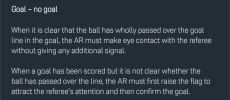So corner, ball crosses the line, but get scooped out the goal. (I raise my flag indicating a goal, same as an offside, but keeping the flag raised). Then the attackers slam the ball into the back of the net.
So I lower the flag, as I'm happy a goal has been scored and run to the halfway line.
A few people had noticed the flag so start saying a load of rubbish. Ref comes over, did you flag for the ball crossing the line "yes". Jobs a good one.
So question is, once flag goes up, keep it up?
So I lower the flag, as I'm happy a goal has been scored and run to the halfway line.
A few people had noticed the flag so start saying a load of rubbish. Ref comes over, did you flag for the ball crossing the line "yes". Jobs a good one.
So question is, once flag goes up, keep it up?



